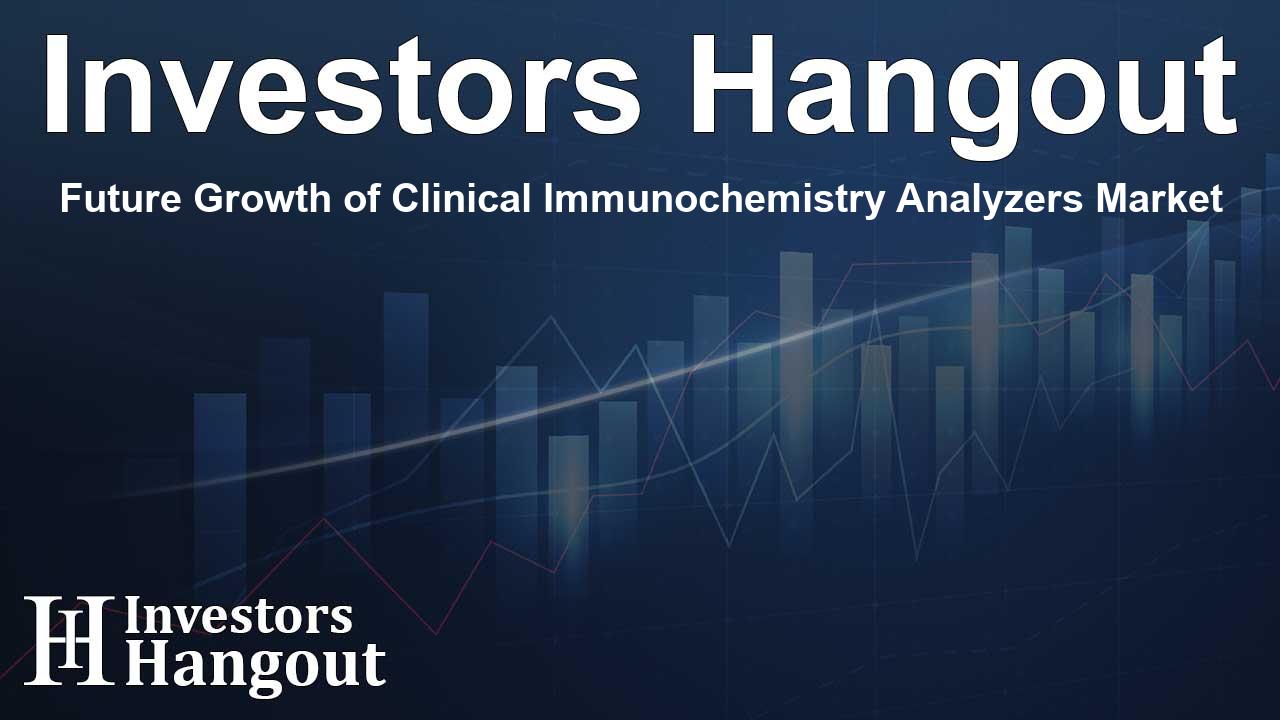Future Growth of Clinical Immunochemistry Analyzers Market

Understanding the Clinical Immunochemistry Analyzers Market
The clinical immunochemistry analyzers market is experiencing a promising trajectory, projected to rise from an estimated value of USD 4.5 billion to nearly USD 6.9 billion within the coming decade. This reflects a compound annual growth rate (CAGR) of 4.4%, stemming from a surge in chronic diseases and increased public awareness regarding early diagnostic measures. Innovations in immunoassay technologies and enhancements in automation contribute significantly to more effective and precise diagnostic procedures.
The Role of Technology in Market Growth
The Impact of AI and Automation
Recent trends illustrate a notable integration of artificial intelligence (AI) and machine learning (ML) into diagnostic platforms, further elevating accuracy and optimizing workflows. These advancements facilitate a more favorable environment for growth while also addressing existing challenges like regulatory hurdles and cost management. The potential for improved healthcare outcomes through digitization positions the market for significant advancements in the years to come.
Market Segmentation Insights
Product Types and Applications
In exploring the market segmentation, it becomes clear that immunoassay analyzers dominate, commanding around 55% of the market share due to their prevalent use in medical environments such as hospitals and diagnostic labs. Reagents follow closely behind with approximately 30% share, which emphasizes the growing demand for quality reagents critical for accurate test results. The remaining share is taken by software solutions, which are increasingly relevant as lab environments modernize.
When categorized by application, infectious disease diagnostics take the lead, securing a significant 40% market share primarily driven by heightened awareness following global health events. Oncology accounts for 25%, linked to the rising incidence of cancer and corresponding demand for accurate diagnostics.
Technological Advancements Leading the Way
Preferred Methods in Diagnostic Technologies
Among the technologies employed, Chemiluminescence Immunoassay (CLIA) remains the most universally chosen, representing 40% of the market share. Followed by the Enzyme-linked Immunosorbent Assay (ELISA), which captures 30% share, particularly appreciated for its cost-effectiveness and ease of use. Other methodologies like Radioimmunoassay (RIA) and Lateral Flow Assays (LFA) also contribute to the diversity of diagnostic techniques available today.
Identifying Consumer Segments
End User Analysis
Hospitals represent the largest segment of consumers, making up 60% of the demand. The clarity in this dependency stems from the need for rapid and reliable diagnostic results to manage patient care efficiently. Diagnostic laboratories, contributing around 25%, are growing as healthcare providers increasingly outsource services to specialized labs.
Regional Market Dynamics
Global Insights
North America currently leads the global market, anticipated to generate around 45% of total revenue. This dominance is attributed to advanced healthcare systems and high levels of R&D investment. Europe closely follows with about 25% market share, benefiting from strategic partnerships and a strong regulatory framework.
The Asia-Pacific region shows remarkable growth potential, expected to capture 20% of the market by 2024. Factors such as improved healthcare infrastructure and rising disposable incomes in countries like China and India influence this rapid expansion.
Future Market Developments
Market Drivers and Challenges
The ongoing rise in chronic illnesses is driving demand for consistent monitoring through clinical immunochemistry analyzers. Additionally, technological innovations enable faster and more efficient diagnostic processes, opening doors for growth. However, the market does face challenges including regulatory barriers and supply chain issues, which stakeholders need to navigate effectively.
Despite these hurdles, the future outlook remains bright, with increasing investments in digital health solutions and the push for personalized medicine further fueling market momentum.
Frequently Asked Questions
What is the projected growth rate for the clinical immunochemistry analyzers market?
The market is expected to grow at a CAGR of 4.4%, reaching approximately USD 6.9 billion by 2034.
What factors are driving demand for immunochemistry analyzers?
Key drivers include the rising incidence of chronic diseases, heightened public awareness of disease diagnostics, and advancements in technology such as AI and ML.
How is the market segmented?
The market is segmented by product type, application, technology, and end users, with hospitals and diagnostic laboratories being the primary consumers.
Which technology is most widely used in clinical immunochemistry?
Chemiluminescence Immunoassay (CLIA) is the most widely used technology, accounting for around 40% of the market share.
What regions are leading in this market?
North America leads the market, followed by Europe and the Asia-Pacific region, which is poised for substantial growth.
About The Author
Contact Lucas Young privately here. Or send an email with ATTN: Lucas Young as the subject to contact@investorshangout.com.
About Investors Hangout
Investors Hangout is a leading online stock forum for financial discussion and learning, offering a wide range of free tools and resources. It draws in traders of all levels, who exchange market knowledge, investigate trading tactics, and keep an eye on industry developments in real time. Featuring financial articles, stock message boards, quotes, charts, company profiles, and live news updates. Through cooperative learning and a wealth of informational resources, it helps users from novices creating their first portfolios to experts honing their techniques. Join Investors Hangout today: https://investorshangout.com/
The content of this article is based on factual, publicly available information and does not represent legal, financial, or investment advice. Investors Hangout does not offer financial advice, and the author is not a licensed financial advisor. Consult a qualified advisor before making any financial or investment decisions based on this article. This article should not be considered advice to purchase, sell, or hold any securities or other investments. If any of the material provided here is inaccurate, please contact us for corrections.
